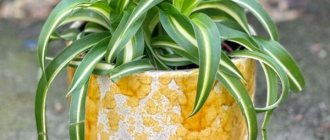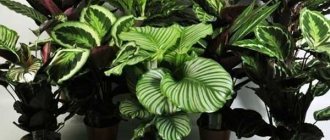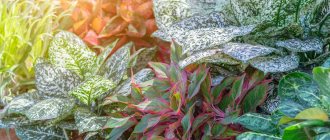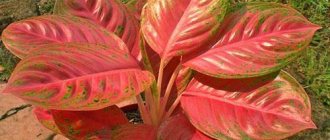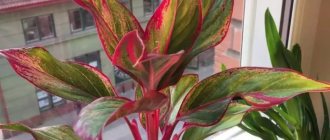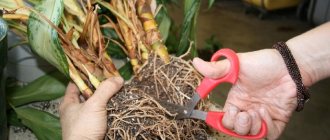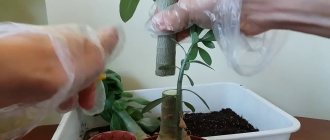A guest from the Asian southeast, aglaonema, despite its distribution in warm and humid India, Thailand, Vietnam and China, grows and develops well in home conditions. Today it is a popular indoor flower.
This plant first became known at the beginning of the eighteenth century in the Philippines. The name was given to the flower a century later by a botanist from Austria. It was formed from two Greek words: “aglos” - bright and “nema” - thread.
Appearance of aglaonema:
- it is a bushy flower with a smooth and straight trunk, from 30 to 80 cm in height;
- Aglaonema's foliage is dense and large, with long petioles;
- the color of the leaves differs in shades of green, with various veins of several colors;
- the plant has no more than 3 inflorescences resembling a cob;
- On the inflorescence you can see fruits, the red peel of which stands out very much against the background of the greenery of the plants.
Where to put an aglaonema flower
The home aglaonema flower should be placed according to whether the species loves light or prefers shade. Most species prefer shaded areas, so a window sill on the south side of the house is unlikely to be a comfortable place to grow them.
It is worth noting that varieties with red leaves tolerate the sun better than others; they love good lighting. The general rule is: if the foliage of the aglaonema is within the boundaries of a right angle (minimum 40 degrees), then the lighting for it is optimal. If the foliage drops lower, the lighting should be reduced slightly.
Growing aglaonema in summer requires some additional darkening; in winter, on the contrary, you need to add a little light.
Reviews from flower growers
I have known Aglaonema for a long time.
First there was Silver, with green and white leaves. Then she grew old and dull, the trunk began to go bald and woody. I ended up getting rid of it when I moved. But I couldn’t live without it for long... Still, a beautiful and unpretentious plant. At the exhibition we purchased an aglaonema with red leaves - the variety is called Crete. We couldn't pass by - super beautiful. Now she is about a year old. She tolerates our dry apartment climate and southern exposure, and still feels good. I water it every other day in the summer, every 3 days in the winter. I wipe the leathery leaves and spray them rarely. <…> I recommend it to beginners and those who have no time to care for plants. Maya5
https://irecommend.ru/content/netrebovatelnyi-drug-foto-aglaonema-crete
This cute flower appeared in my house by accident, but immediately struck me with its unusual color.
He was very unpretentious in watering and care... Always cheerful and persistent. And a couple of months later he gave me a bunch of flowers that looked like small callas... Aglaonema grows like a bush, with a bunch of shoots... Six months later, I decided to plant it in a larger pot and plant a couple of children... So my bush was renewed in a new pot... So it lived with me almost seven months, but for some reason I didn’t see any flowers on it... And then I decided to do what, in my opinion, was right - I again transplanted it into a smaller pot... And after a couple of months my girl again pleased me with her flowers. sunalika
https://otzovik.com/review_887238.html
I have Aglaonema Silver Queen.
It has been with me for more than 5 years and during this time I can definitely say that the flower is unpretentious! In all books they write that aglaonema needs high air humidity, but it also feels great in the usual conditions of city apartments with dry air in winter. Tuktarov03
https://vseotzyvy.ru/item/4683/reviews-aglaonema/
I recently got Aglaonema.
I wanted this particular flower, since my rooms face the north side and I needed a plant that is unpretentious to light. Somehow I never came across a beautiful specimen. One day I went into the store and saw silver aglaonema. I liked it so much that I bought it. At home I transplanted it into a tall pot. I must say, she looks gorgeous. The silvery tint on the leaves gives the plant an unusual appearance. I have had it for one month and during this time it has opened four leaves. I water as the soil dries out. It stands half a meter from the window (north side). I hope it will continue to please me. Becaperehan
https://otzyv.expert/krasivoe-rastenie-foto-1562873
Temperature
It is believed that the ideal temperature for growing aglaonema will be in the range from 20 to 25 degrees. The ideal would be 18 degrees Celsius. Although in winter, if there is a lack of watering, the flower can be left for short periods of time and at a temperature of about 10 degrees.
Sudden changes in temperature, as well as drafts, can be detrimental to this plant. Therefore, they cannot be allowed to occur. It is important to consider the humidity level, which should be high. To do this, you can spray the plant with a spray bottle, while simultaneously cleaning the foliage from accumulated dust.
If in summer aglaonema needs to be sprayed periodically, then during the season of active operation of heating systems, measures to moisten the room and plants in particular need to be strengthened. Placing a pot with a flower on a tray filled with water works well. Naturally, the pot itself should not touch the surface of the water. Occasionally, you can give your plants tropical rain in the shower.
Possible problems
Difficulties that arise during cultivation are associated with changes in the color of the leaf blades. If you find the cause that provokes the symptoms and eliminate it in time, the flower will quickly recover. The appearance of gray spots may indicate the development of a fungal infection. If the leaves are curled, darkened or pale, this indicates incorrect conditions for placing the pot.
Dry spots often indicate excess heat, dry air, or too much sunlight. Brown weeping spots developing in the center of the leaf indicate that the cause should be sought in the underground part. Cutting off the affected area and timely replanting of healthy fragments will help cure a plant if its roots are damaged.
Watering and fertilizing
Caring for aglaonema at home cannot be called very difficult; rather, it brings pleasant troubles, which are rewarded a hundredfold by the contemplation of a magnificent flower.
Watering aglaonema differs depending on the season:
- In spring and summer, when the active growing season begins, active watering and care of the plant is required. Irrigation with water is carried out as soon as the upper part of the substrate dries out.
- In autumn and winter, watering is carried out a little less often, with an interval of two days.
It is important to water the aglaonema only with water that has previously settled and is at room temperature. Do not over-dry or over-moisten the soil, as this can have a bad effect on the plant.
As for fertilizers, an important condition here is the absence of lime in any fertilizer complexes. You can care for the flower using fertilizers with potassium, nitrogen and other microelements.
It is very important to add fertilizer not only to the soil, but also by spraying it on the foliage, which will allow it to actively gain strength. The best time to fertilize is from spring (March) to late summer (August). This should be done twice a week, immediately after watering, at a time when the sun does not hit the flower. In winter, it is not recommended to feed the plant.
Varietal diversity
There are about 50 species of aglaonema in nature.
There are low-growing varieties that do not grow more than 25 cm, medium-sized ones - bushes 40-60 cm high, and tall ones - miniature trees whose height varies from 0.6 to 1.5 m. The most popular varieties can be distinguished:
- Ribbed - this culture is the smallest of all presented. The leaves can be oval or ovoid. Flowering begins at the end of December and lasts only a few days. When grown at home, fruits are not formed.
- Painted is a beautiful variety with bluish-green leaves. Flowering begins in July and continues until the end of August.
- Prosperity. It stands out from other species with its peach-colored leaves. Loves a humid climate and moderate light.
- False bract is a flower that grows up to a meter in height. The glossy lanceolate leaves are green.
- Lux Mix. The variety has large and wide leaves with red veins. The plant is unpretentious; it is enough to water it as the soil dries and periodically fertilize it.
- Changeable (changeable) refers to the Lumina species. This flower with erect stems was brought from the Philippines. It is especially beautiful during flowering, when inflorescences form on a lush bush with long leaves. Then 3-6 buds are formed from each.
- Treiba is one of the most unpretentious species. This tropical beauty has long and elongated leaves that can reach 15-20 cm.
- Mongol. It stands out from the rest with its dense, leathery foliage. This variety also does not require special care and conditions. Feels great both on a sunny windowsill and in partial shade.
- Maria Christina. A beautiful bush with a lush crown, growing up to 50 cm. The green leaves are ellipsoidal in shape. Silvery inclusions are clearly visible on the outside.
- Crete is one of the varieties of red aglaonema. You can recognize the flower by its characteristic red leaves.
- Legacy is a very beautiful variety with colorful foliage. The tricolor includes grey, green and pink.
- Amelia is a medium-sized flower with glossy leaves. Easy to care for, because it only needs to be watered and fertilized.
How to make aglaonema more bushy
Aglaonema does not grow at a very fast pace; in order for its foliage to develop efficiently and richly, it is important to keep the roots in a tight pot. The main thing is that there are holes in its bottom for ventilation.
The following tricks will help you make the plant bushy:
- Trimming shoots at a distance of 5 cm from the ground. The cuts should be sprinkled with coal dust.
- The cut shoots are rooted in water and then planted next to the main plant.
- To stimulate the growth of additional leaves, you can pinch the buds located on top.
How to care for a plant at different times of the year
Aglaonema, like other plants, is sensitive to the seasons. Caring for this flower in different seasons is slightly different:
- Summer: This is the period when the plant actively blooms. It is necessary to replant the aglaonema into a larger pot with mandatory abundant watering and spraying. It is important to ensure that the air temperature remains at the same level. At this time, the plant is actively fed with fertilizers.
- In autumn: growth slows down, now you can reduce the intensity of watering. Bait feeding should be stopped at this time.
- In winter: a resting phase begins when it is enough to periodically spray the aglaonema with water in order to maintain a normal moisture balance. The air temperature must be reduced to 17 degrees so that the plant can rest.
- In spring: the time comes that is optimal for replanting a flower. Once every 5 years, the soil of mature plants changes and spring is the most suitable time for such a procedure. Be sure to wash the leaves from dust using water at room temperature and water the plant abundantly. Now is the time to apply fertilizing.
How to transplant aglaonema correctly
Replanting aglaonema has its own significance; a flowering stem will not long please with green foliage in a pot that is too cramped. Moreover, young plants are replanted annually, due to the speed of their growth, and mature ones - a little less often. The following principles for replanting this plant can be noted:
- Soil: the substrate should be crumbly, as for heather or azalea. A mixture of humus, sand and charcoal mixed with soil is perfect.
- Pot: a young plant needs a diameter of 12 cm, and a mature one about 18 cm. It should not be too deep.
- Drainage is required; you can add some pebbles to the soil.
- Time: the greatest benefit from replanting is achieved if it is carried out at the very beginning of spring. At the same time, you can divide the bush into shoots and plant them separately to increase bushiness.
- After replanting, 3 weeks later, you need to fertilize the soil in the pots. This can be done using the following means: “Lignohumate”; "Agricola"; "Effecton".
The best varieties
Maria
Aglaonema Maria
This variety has very expressive white spots and occupy 80% of the leaf plate. Due to this, she looks very attractive. The height of an adult plant of this variety is 60 cm, and the leaf plates grow to a length of 20 cm. The flowering of Aglaonema Maria is a white cob with a white bridal veil.
Red
Aglaonema red
The species is represented by one variety of Aglaonema - Crete.
Crete
Aglaonema Crete
The variety has a height of up to 70 cm. The stems grow straight and have beautiful leaf plates with unrealistic colors: several shades of green with a beautiful and clear red border. The length of the leaf is 15 cm. The flowering of the cob is practically invisible, since it is covered, like a hood, with a white blanket.
Treiba
Aglaonema Treiba
Aglaonema is very low maintenance. The length of the leaf blades reaches 16 cm and alternates green and light green stripes. At the same time, the pattern is contrasting, it blooms with a white cob with a white cover.
Ribbed
Aglaonema ribbed
Malaysia is considered the birthplace of the species. This is practically the smallest species, specimens of which grow no more than 20 cm. The leaf blades have an emerald color, along which there are strokes of a white shade. This species also has a second variant, where the foliage remains green and only the vein located in the center of the leaf is white. It blooms with a white spadix with a white-green spathe.
Short-covered
Aglaonema Short-covered
This plant's trunk spreads underground, with almost only leaves above it. These are oval leaf plates, narrow with a sharp end. Their design is on a dark green background, with stripes of light emerald color running from the center.
The plant grows very slowly. Flowering - white spadix with white spathe.
Round
Aglaonema Round
A low-growing species with dark foliage shaped like a pointed heart. On dark leaf plates, pink veins stand out beautifully; the color of the veins can vary depending on the variety. Depending on the variety, the spathe of the cob may be white or slightly pinkish in color.
Silver Queen
Aglaonema Silver Queen
The compact plant, growing to a height of about 30 cm, has dark green leaf blades on which there are lighter spots. The leaf length is 15 cm. It blooms with a white cob, covered on one side with a white blanket.
Modest
Aglaonema Modest
The species considers its homeland to be the tropical zone of China and Bangladesh. A strongly branched small shrub with masses of bright green foliage. An absolutely unpretentious variety that requires practically nothing except watering. It tolerates full shade well, which cannot be said about other plant varieties. The height of the plant is only 50 cm. The length of the leaf plate is 20 cm. The flowers are collected in a white cob and covered with a white-green blanket.
Silver Bay
Aglaonema Silver Bay
An impressive tall specimen. The height of an adult plant is 100 cm; this variety is frost-resistant, but this does not allow it to grow on our street in the winter; it simply tolerates the cold well. The leaf blades are up to 30 cm long. In the center of such a green plate there is a light spot surrounded by lighter spots.
As the leaf ages, it becomes darker green. Flowering occurs with a white ear with a white spathe.
Stripes
Aglaonema Stripes
This Aglaonema is also called “striped”. The leaf blades are oval in shape with a sharp end. The length of the sheet is 35 cm, despite the fact that the width is 14 cm, there are three shades on the sheet:
- Silver shade.
- Dark green color.
- Light green color.
Due to the fact that the alternating stripes converge at the end of the sheet, the resulting light stripes form a small silvery spot. It blooms with a white cob.
Friedman
Aglaonema Friedman
This variety also has other names - Gabriel or Cecilia. The height of the bush is 150 cm, and the leaf blades are very decorative. They are very large and have dark green spots on a bright field. The edges of the sheet bend in a wave.
The variety is not whimsical and the flowering does not differ from other varieties.
Pattaya beauty
Aglaonema Pattaya Beauty
Thailand is considered the birthplace of the variety, where it can be found in the wild. The variety has tall growth and charming foliage. The foliage is green, along which olive spots are located; along the edge of the leaf there is a dark green stripe bordering the leaf. The length of the leaf blade reaches 12 cm. Flowering does not differ from other varieties - a white ear with a spathe of the same color.
Whatever variety is chosen, it needs appropriate care.
Diseases and pests of aglaonema
Aglaonema, like other indoor plants, is susceptible to diseases and pests, which require timely control to prevent the death of the flower.
Table: errors in care and their elimination
| Problems | Causes | Elimination |
| The tips of the leaves dry out | The air in the room may be very dry. | Spraying foliage with warm water |
| The leaves curl and develop brownish rims. | Periodic drafts and unstable air temperature | Eliminate drafts, move the pot with the plant away from the window |
| Whitish spots appear on the foliage | Sunburn | Hide the plant from direct sunlight, after a while spray with warm water |
| The plant stops growing, the leaves turn brown | Watering with cold and hard water | Watering with water, which must settle for 1–2 days |
| Droplets of liquid collect on the leaves | Excessive watering, excess nitrogen in the soil | Remove nitrogen-containing fertilizers and ensure regular watering |
| The leaf begins to turn yellow | The plant is watered too often, air temperature is low | Adjust the temperature or move the plant to another room, control the intensity and frequency of watering |
| Foliage loses color brightness | The flower is in the shade, lack of microelements | Preventing illness, feed the flower. Add artificial correct light |
| The flower doesn't grow | The pot is too big | Change the pot to a smaller one |
Table: diseases and pests of aglaonema
| Diseases and pests | Signs of infection | Causes | Treatment options |
| Rust | Rusty spots on the underside of the foliage | Fungus and lack of air movement in the room | Remove diseased leaves and organize ventilation. Treat the plant with Mancozeb |
| Leaf spot | Brown spots on leaves that gradually begin to become wet | Fungus or overwatering | Optimize watering, remove affected foliage. Carry out fungicidal treatment |
| Stem rot | The stems of the plant begin to rot | The soil is too moist, the air in the room is stagnant | It is better to get rid of the diseased plant |
| Blackleg | Darkening of the cuttings | Due to too wet and dense soil | Throw away the infected cuttings |
| Mealybug | A coating resembling cotton wool appears on the leaves | Indoor air is too dry | 1. Remove the flower from other plants. Remove or treat all contaminated parts. 2. Application of insecticides (“Commander” or “Fitoverm”). 3. After a week, repeat the treatment to destroy the larvae. |
| Aphid | Small insects are visible on the shoots | Appears due to contaminated soil or plant | Application of insecticides: Bankol or Akarin. |
| Whitefly | White dots on leaves, their deformation | The use of neonicotinoids, as well as Iskra, Intavir, with their obligatory alternation. |
Description
Aglaonema (Aglaonema) is a perennial herbaceous evergreen representative of the plant family Arumaceae, a poisonous bushy plant with straight fleshy stems. The leaves of Aglaonema are elongated, lanceolate, and dense to the touch. Depending on the variety, there are different color variations: from solid green to all kinds of variegated combinations . The small pale yellow flowers do not have much decorative value and are called “spear with a veil.”
Under natural conditions, aglaonema grows in the tropical rainforests of India, Thailand and other countries. Most often found in coastal areas. In botany, it is known that there are more than 20 natural varieties of this tropical plant.
Flower growers love aglaonema for its relative unpretentiousness. If simple growing conditions are observed, the plant can easily take root in an apartment, and sometimes blooms and produces fruits even more often than naturally occurring specimens.
Aglaonema creates a discreet style in the interior
At each time of the year, aglaonema requires different maintenance conditions. It is important to remember that plants with bright leaves are contraindicated in direct sunlight. When they come into contact with aglaonema, the leaves “burn out”, become pale, and lose all their attractiveness. Therefore, variegated aglaonemas are best grown in partial shade.
Table: optimal conditions for home maintenance of aglaonema depending on the season
| Season of the year | Room temperature | Air humidity | Lighting | Top dressing | Watering mode |
| Winter | Not lower than 18 °C, no drafts | Medium (2–3 sprays per week) |
| Not required | Moderate, once a week |
| Spring | 20–22 °C | Once every two weeks | Abundant, as the earthen clod dries out | ||
| Summer | Not higher than 25 °C | High (daily spraying and placing the pot in moist peat) | |||
| Autumn | 20–22 °C | Medium (2–3 sprays per week) | Once a month |
Methods of propagation of aglaonema
This plant can be propagated by all popular methods, including using seeds, cuttings and planting rhizomes.
Propagation by seeds
The easiest way to propagate aglaonema is through seeds; it is not too labor-intensive. This method allows you to obtain all the characteristics of the mother plant, and, therefore, perfectly adapt them to the surrounding space; the flowers will not experience difficulties with acclimatization. However, there is always a risk of producing foliage different from the parent.
You can propagate by seeds like this:
- during the formation of fruits on an adult plant, there is no need to remove them until they are fully ripe;
- when the fruits turn red, they can be removed (they should remain in the hand when touched);
- The plant should be propagated in the spring by planting seeds in light soil and covering with polyethylene;
- You need to water the plants little by little, but often enough;
- The secret of seed germination is to plant them immediately after harvesting, because they quickly lose their quality.
Cuttings
Aglaonema can be replanted by separating cuttings. This type of propagation allows you to grow a strong plant in a short time.
The cutting process goes like this:
- cuttings must be separated before the plant begins to bloom;
- A stem with branches is perfect for this purpose;
- The cut areas must be sprinkled with coal dust;
- the cutting must dry for 24 hours;
- it needs to be rooted in a previously prepared sand-peat substrate;
- the cuttings are planted in moist soil to a depth of 5 cm;
- The seedling should be covered with polyethylene and left for 3 weeks at an air temperature of 25 degrees.
Using rhizomes
Aglaonema can be propagated by dividing its rhizomes; a plant that has grown too much and has produced many young shoots is suitable for this purpose. They are the ones that are used when choosing this method.
By division, you need to plant those shoots that are sufficiently developed, have strong foliage and healthy strong roots. Seedlings must be carefully separated from the adult plant, divided into pots and carefully planted in the ground. Deepening it by 5–6 cm. After which you need to water the plant abundantly.
To help root aglaonema, you can cover the seedlings with polyethylene or a glass jar, creating the effect of a greenhouse with high humidity underneath. Regular watering and spraying will help the plant actively develop and grow quickly.
Flowering: timing, duration
Domestic exotics bloom very rarely; due to the slow growth of the hybrid, it becomes even more difficult to achieve flowering. Aglaonema Siam Aurora and Crete are related varieties whose flowering is the formation of an inflorescence similar to an ear of corn. It traditionally has an oval shape, covered with dense light fabric. It takes a lot of effort for a flower to form an ear.
After the protective film-cloth falls off, a dense white bud is revealed underneath, which resembles a reed in shape and structure. The result of flowering is the formation of a bright red fruit with poisonous properties.
With careful and long-term care, Crete blooms in summer for 2 or 2.5 weeks. A single seed is formed inside the fruit-berry. You can grow a full-fledged flower from it.
Toxicity of Aglaonema
Aglaonema, which belongs to the aroid family, like most of its other representatives, is poisonous. This plant is considered dangerous to human health. However, it's not all that scary. For full poisoning, you need to eat several leaves, which an adult is unlikely to do.
Precautionary measures:
- the plant should be kept away from children, especially during the ripening period of the fruits, which have a very attractive color;
- When working with aglaonema, you need to beware of the juice that may be released (for this you need to wear gloves, watch the tools that are used), and not allow it to get on the mucous membranes of the body.
In general, the plant does not pose a great danger; it is important to be careful about its placement, closely monitor children and teach them safety precautions. After this, all that remains is to enjoy the appearance of the aglaonema, its picturesque, lush leaves and bright colors.
History of appearance
The representative of the flora is widespread in its homeland. Surprisingly, it was brought to Europe from Malaysia.
Aglaonema is similar to Dieffenbachia
The history of domestication began in the 19th century. Until now, the plant is one of the most beautiful and unique inhabitants of the tropics.
Some specimens have become an integral part of the collection of the British Botanic Garden. They were used by employees in breeding work, which resulted in hundreds of popular hybrids and indoor varieties. All of them enjoy the attention of flower growers.
